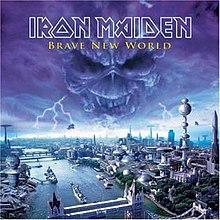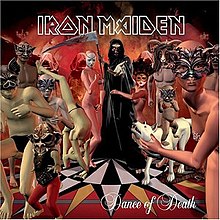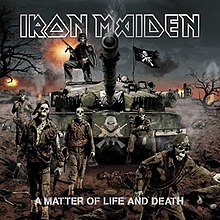Part four: The return of the King: Dancing in the brave new world
I've written extensively about Bruce Dickinson's comeback Iron Maiden album, 2000's “Brave new world”, so I won't go into it in any more detail here (if you want to read my review it's on page one of my journal), but the return of both Bruce and longtime guitarist and founder member (almost) Adrian Smith breathed new life into what was in some ways becoming a tired band who seemed unsure of the direction they were heading in. Janick Gers remained, so that Maiden now had three guitarists, and the new sound was a joy to behold.

“Brave new world” was well-titled (although it is of course the title of Aldous Huxley's novel), being released in the first months of the new millennium, and with most of the original Maiden lineup back in the fold. The fans reacted as expected, and sellout tours resulted. The album was critically acclaimed as one of Maiden's best ever, ranking up there with “Number of the Beast”, “Powerslave” and “Seventh son”: high praise indeed!

2003 saw the release of “Dance of death”, which while retaining the heavy classic sound of Maiden, expanded on “Brave new world”'s leaning towards longer, more epic songs and complex structures, tipping the scales towards progressive metal rather than outright metal. Although this came as something of a shock to some, it serves to underline and address the problem I laid out earlier, that the Blaze-era Maiden had little in the way of new, original songs and seemed to be falling back on older melodies and ideas, which served to make both the albums he recorded with Maiden seem a little stale and unimaginative.
Now, to be fair to Blaze, there was definitely a need for a change: “Fear of the dark” was largely an unremarkable album, and Dickinson's time away seemed to only have done him, and the band, good, giving them a new zest for their music and a whole host of new ideas. It's sad in a way to see Blaze Bayley as a “placeholder”, marking time for the return of Dickinson, but the truth of it is that that's how it turned out, even if that wasn't the original intention. Whatever, the re-energised Iron Maiden were going from strength to strength, and “Dance of death” was another step along that path to regained glory, with some excellent tracks in “Rainmaker”, “Montsegur” and of course the title track.
The guitars are back in charge! Steve Harris plays keyboards on the album, but they're nowhere near as much in evidence as they were on the previous album. A track like “The angel and the gambler” from that album was basically built on the keyboard melody: here, the keys are very much ancillary, a backup instrument to enhance, not take over or change, the sound. As it should be. Even the longer tracks, like “No more lies”, “Paschendale” and the title track, which could have been filled out with synth and keyboard, are instead crammed with guitar. And why not, with three great axemen?
Let there be no doubt however: Iron Maiden were moving, and continue to move, in a more progressive metal direction, away from the harder, “pure” heavy metal of their early days. They added to their sound, expanding upon it and writing longer and more complicated songs, like the title track, and “Paschendale”, both over eight minutes long. Of course, Maiden have never been a stranger to epic songs --- “Rime of the Ancient Mariner" still stands as their longest ever, at just over thirteen minutes, but whereas albums prior to the Blaze era had generally tended to have shorter, snappier, more commercial songs --- the last really long track before “X Factor” was the title to 1988's “Seventh son of a seventh son”. Since the departure, and return of Bruce Dickinson, Maiden tended to shy away from the shorter songs, with seven out of ten of the songs from “Brave new world” being over six minutes, and six, almost seven of those on this album being of that length (“Montsegur” is 5:50). In fairness, the Blaze albums produced a total of 5/11 for “X factor” and 5/8 for “Virtual XI”, whereas “Fear of the dark” boasted a mere 2/12, while
not one of “No prayer for the dying”'s eleven tracks were over that length, so there has been a definite progression into longer tracks since 1995.
“Dance of death” also distinguishes itself from other Maiden albums in being the first album of theirs in twenty years to feature a totally acoustic number, the closer, “Journeyman”, very much a departure from form for Maiden, but it works exceptionally well, the more for the fact that it's so unexpected. I think the last acoustic song they did was “Prodigal son” on 1981's “Killers”, but don't quote me!

Another three years later saw the release of “A matter of life and death”, with a somewhat similar title to the previous album, and no doubt a nod back to the live opus “Live after death”. No matter what criticism is levelled at them, no-one can deny that Maiden remain the potent force in British Heavy Metal that they always have been, and despite ageing (as we all do), their music is still relevant and powerful, as opener “Different world” shows in spades. Recent Maiden albums have all tended, if not to be actual concept albums, to have a certain theme running through them, and here it's the horrors of war, driven home powerfully by the artwork on the album cover, showing an army of dead marching before a tank, like a modern version of Brueghel's
El triunfo de la muerte.
This album maintains the high ratio of long-to-short songs, with songs over six minutes coming in at 7/11, three of these being over eight minutes, with five, almost six over seven minutes. The song structures became more complex and intricate over the last few albums, and here you can certainly see that in tracks like “Brighter than a thousand suns”, “The longest day” and the closer, and longest (at over nine minutes long) “The legacy”, but even the shorter, snappier songs have their place. “The pilgrim” is a great little song, although in my own nitpicking opinion Maiden write too many songs with the word “the” in the title!
“Out of the shadows” revisits one of their favourite themes, that of prophecies and chosen ones, and “The reincarnation of Benjamin Breeg” features some of Dave Murray's best work since “Powerslave”. The album is certainly dark, though to be fair so was the previous one, with its obsession with and examination of the process of death, but it's also an angry album, and there's nowhere the vitriol comes to the fore more than in “For the greater good of God”, where writer Steve Harris spits out his contempt for the idea of religious wars. This is also the longest track on the album, beating out closer “The legacy” by two seconds!

Last year, 2010, Iron Maiden released their fifteenth, and to date, most recent album, the critically acclaimed “Final frontier”. This is also their longest ever album, clocking in at an amazing seventy-six minutes thirty-six seconds, with the opening track almost nine minutes long and the closer one second off eleven. Not surprisingly then, the ratio is again 7/10, almost 8, as “Coming home” runs for 5:52. It's also their best effort since “Brave new world”, perhaps even since “Number of the Beast”. Yeah, it's
that good!
Opener and almost-title track “Satellite 15... the final frontier” lays down the gauntlet, with a multi-layered, complex and intricate composition, introduced on a lengthy instrumental passage more expected of a prog-rock band. It's actually quite understated and restrained, taking almost four and a half minutes before it finally takes off. “El Dorado”, on the other hand, kicks right off from the start, with a
very familiar guitar riff (from “Wasted years”, I think) and a great vibe.
The more complex arrangements shine through on tracks like “Isle of Avalon” (which has definite echoes of the title track to “Powerslave”), “The talisman” and the epic closer, “When the wild wind blows”. There's definitely a sense of Maiden maturing, growing and learning new tricks over the course of the last three or four albums. You can of course hear the common themes leaking in, but there's more than enough new ideas there to make every song stand out on its own merits.
All through their career Iron Maiden have led the field, turning out classic album after classic album, building on their fanbase, playing bigger and bigger venues and opening up the world of heavy metal to successive younger generations. There are few metal bands around today who would not admit to owing at least a little of their success to the venerable elder statesmen of heavy metal, whether it's that they listened to them when younger, or they influenced their style, or even just showed that a bunch of guys from London can scale the heights of worldwide fame with nothing more than their innate talent and some perserverance.
It would be wrong to say Iron Maiden created heavy metal --- of course, it was around, though mostly known as hard rock at the time --- for decades prior to their arrival. But what is in no doubt is that they were one of the shaping forces behind metal, indeed behind rock, and remain so to this day. After over thirty years together, Iron Maiden show no signs of slowing down. They've had their problems, they've been through their changes, btu they've come out the other side stronger and more potent than ever before. They've innovated, moved with but not been shaped by the changing trends, and have always remained true to themselves, their fans and their own unique sound.
What was it Ozzy Osbourne said? You can't kill rock and roll? Truer words were never said, and Maiden go from strength to strength, proving that good old-fashioned honesty and hard work is sometimes all you need to make it in this world. Lessons some other bands would do well to take to heart.
Long live the Beast!